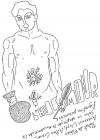Career
Cravan set out to promote himself as an eccentric and an art critic, though his interest was showing off a powerful, striking personal style rather than discussing art. He staged public spectacles and stunts with himself at the centre, once acting on the front of a line of carts where he paraded his skills as a boxer and singer, although he never pursued either of these activities on stage with anyone else. His style of looking for the striking and shocking had some roots in the contemporary cult of the young man of action (athletes, soldiers, flamboyant artists) but strongly prefigured dadaism.
From 1911 to 1915 he published a critical magazine, Maintenant! ("Now!") which appeared in five issues. It was gathered together and reprinted by Eric Losfeld in 1971 as J'étais Cigare in the dadaist collection "Le Désordre".[5] The magazine was designed to cause sensation and in a piece about the 1912 arts salon he criticized a self-portrait by Marie Laurencin, remarks which drove her lover and influential modernist critic Guillaume Apollinaire to fury and a bid for a duel. But his rough vibrant poetry, and provocative, anarchistic lectures and public appearances (often degenerating into drunken brawls) also earned him the admiration of Marcel Duchamp, Francis Picabia, André Breton, and other young artists and intellectuals.
After the First World War began, Cravan left Paris to avoid being drafted into military service.[5] On a stopover in the Canary Islands a boxing match was arranged between Cravan and the reigning world champion Jack Johnson to raise money for Cravan's passage to the United States. Posters for the match touted Cravan as "European champion." Johnson, who didn't know who the man was, knocked Cravan out solidly and in his autobiography noted that Cravan must have been out of training.
In retrospect, the incident has been cited as an archetypal example of the "anyone can reinvent himself" philosophy found in later artistic movements—Cravan didn't need to be a professional boxer to lay a claim on being world champion. His personal style involved continuous re-invention of his public persona, and outrageous statements and boasts. His pride in being the nephew of Oscar Wilde even produced hoaxes—documents and poems—Cravan wrote and then signed "Oscar Wilde". In 1913 he published an article in his self-edited review Maintenant claiming that his uncle was still alive and had visited him in Paris. The New York Times published the rumor, even though Cravan and Wilde never met.
After arriving in New York in 1914 where he met the poet Mina Loy, then moved on to Mexico three years later for the same reason when the United States entered the war. After their marriage in 1918 they planned a trip from Mexico to Argentina.[citation needed] Without enough money for both of them to book passage on the same vessel, Loy took the trip on a regular ship[6] and Cravan set out alone on a sailboat to Argentina.[7] Cravan never arrived[8] and it is presumed that he capsized and drowned in a storm raging at sea in the following days.[9]






